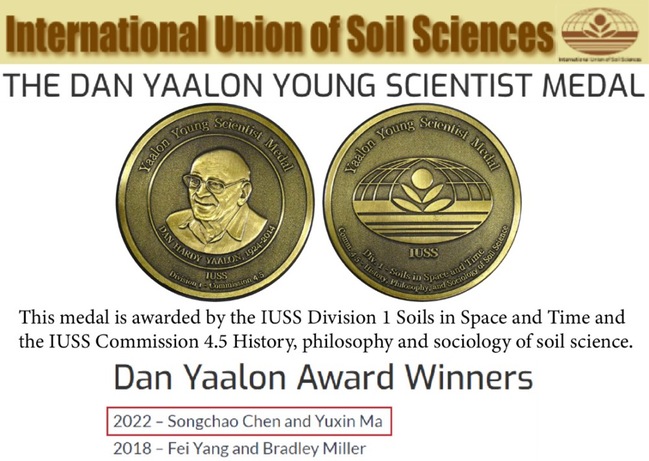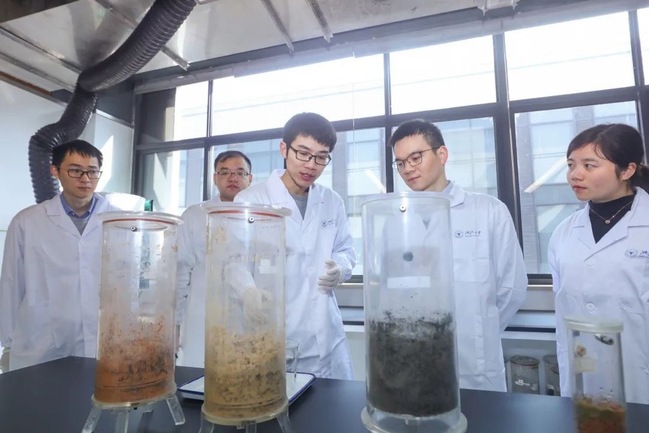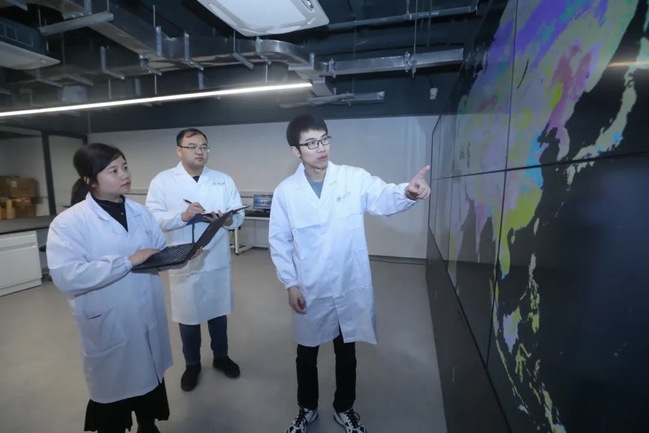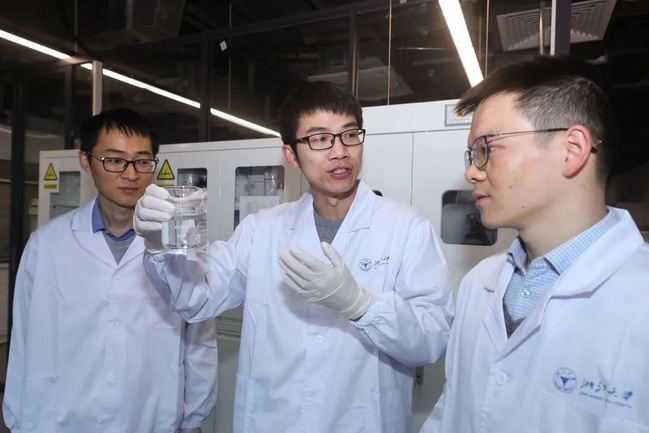The 2nd “Dan Yaalon Young Scientists Medal” winners were announced lately. Songchao Chen, a young PI from Soil Pollution Control and Remediation Innovation Workshop of the Center, won this honor.

The “Dan Yaalon Young Scientist Medal”, in memory of Dan Yaalon (1924-2014), a prestigious scientist in soil science, is awarded to the young scholars who have obtained their doctorates within the last five years and who have made significant contributions to and have great potential in the fields of soil geography, soil occurrence, soil classification, soil morphology and micromorphology, quantitative pedology, paleosol, as well as history of soil science, philosophy and sociology. As the only award by the International Union of Soil Sciences for young scholars, the medal is awarded every four years to a total of two winners.

Songchao Chen, a young PI of the Center, got his Ph.D from National Research Institute for Agriculture, Food and Environment, France and Agreenium (the agronomic, veterinary and forestry institute of France), was granted the “Dan Yaalon Young Scientist Medal” (2022) and the 2019 Best Paper Award in Quantitative Soil Science of the International Union of Soil Sciences. So far he has published over 60 SCI papers, among which he has published more than 10 SCI papers as the first author in Geoderma and other top journals of soil science, and got 1 national invention patent.
Dr. Songchao Chen, born in the 1990s, is a young scientist from Soil Pollution Control and Remediation Innovation Workshop of the Center. Why was he awarded this distinguished global honor? What has he achieved so far?
The official statement goes like this:
Dr. Songchao Chen’s research is of great significance to large-scale soil quality monitoring and management, soil ecological service function assessment, etc., and he has made contributions to the field of soil temporal and spatial evolution.
Large-scale soil quality monitoring and management, soil ecological service function assessment... What do these high-sounding terms mean? What meaningful work is Dr. Chen doing? He introduced to us with a smile, “My research, put it bluntly, is doing ‘physical examinations’ of the soil”.
Big Data Modeling Makes Soil “Physical Examinations” Accurate
Soil pollution prevention and control is a worldwide research project. Unlike air pollution or water pollution, once pollution occurs, it can be observed immediately; however, soil pollution can only be detected after a period of time, so there is a certain lag. Meanwhile, due to different industries and characteristic pollutants in different regions, it is impossible to generalize soil pollution, so we need to propose targeted solutions to precise prevention and control.
Dr. Chen made an analogy that the polluted soil is like a “patient”. How to “cure” the polluted soil? The first thing is to “prescribe targeted medicine”. However, the spatial distribution of soil information was often inaccurate, and usually a large particular area was marked with a certain feature due to technical limitations in the past.

But, is this the truth? Even soils in different villages or different patches of farmland are different, let alone in different cities or countries. Therefore it is significant to make an accurate calculation of these data, analyze the changes of soil quality in time and space sequence, integrate them into the same big data system, and make accurate prediction and analysis. “If we say traditional soil surveys are like taking the pulse in traditional Chinese medicine, only a rough guess is made about the general problems in a large strip of soil. Our research is like the ‘integration of traditional Chinese and Western medicine’, which can make us realize the problems on the surface, and understand the specific location and characteristics of the ‘sick’ soil in detail as CT does,” Dr. Songchao Chen explained.
Relying on the empirical judgment of experts, traditional soil survey and mapping technologies show problems of long cycle, high cost, slow updating and low accuracy, as well as inaccurate monitoring and management of large-scale soil information. In response to this situation, Dr. Chen proposed a new digital soil mapping technology. With a hybrid spatial prediction model integrating machine learning and geostatistics, he has made key soil attributes (organic matter and pH) products of national-scale 90-meter spatial resolution for the first time in China.

Dr. Chen also said, “By mining the correlation between soil sample information and environmental variables, the accurate representation of soil data from point to surface, and to three-dimensional space can be realized, and the spatial distribution of soil information can be intelligently analyzed in real time, efficiently and accurately so as to provide strong support for territorial resources surveys, soil quality monitoring and pollution risk assessment.”
In addition, Dr. Chen has developed the space fine representation technology of space-ground integrated soil information, discovered more soil-environment remote sensing big data, coupled geostatistical and machine learning models, and achieved high-resolution, high-precision digital soil mapping. Currently being developed by ZJU-Hangzhou Global Scientific and Technological Innovation Center, the technology aims at providing data support for understanding China’s soil resources, assessing the transformation of soil carbon sinks and sources and carbon neutrality under climate change, and promoting China’s soil big data information platform and serving China’s soil environmental management.
Accurate Assessment, Dynamic Governance and Digital Soil Constructing Ecological China
Accurate monitoring is for accurate and dynamic governance. Dr. Songchao Chen said that soil pollution is caused by many factors, of which human activities have the greatest impact. For example, a patch of land used to have the soil of good quality when it began to be monitored and then, a factory with heavy pollution was built there and soil may be polluted. For another case, for the same land near a factory, there are different pollution levels for the soil with different distances from the factory.

“Making a good soil big data platform is only the first step in soil pollution prevention and control. We also need to monitor and remediate soil dynamically,” Dr. Songchao Chen said, and he will work with other PI and post-doctoral fellows from Soil Pollution Control and Remediation Innovation Workshop of the Center, and make good use of the front-end remote sensing big data monitoring technology, as well as the back-end micro-nano remediation materials, technologies and equipment to form full-process remediation and governance.
Lucid waters and lush mountains are invaluable assets!
Before returning to China, Dr. Songchao Chen worked at National Research Institute for Agriculture, Food and Environment, France. He said, compared with European countries and the United States, China still faces severe soil environmental pollution and research gaps in related fields. Therefore, it is imperative to speed up research and innovation in soil environment in-situ monitoring, remediation technology, materials and equipment, and environmental information management so as to work for national pollution prevention and control strategy and promote the commercialization and industrialization of soil pollution prevention and control.

Lucid waters and lush mountains are invaluable assets. Dr. Songchao Chen is happy to find that eco-civilization has been more and more popular in the past few years, and there are great advances in soil pollution prevention and control in China. A series of initiatives have been made. In 2014, China launched the first national survey report on soil pollution; In 2016, China issued the “Soil Pollution Prevention and Control Action Plan” and initiated the Second National Pollution Source Census and Detailed Survey of Soil Pollution; in 2019, the “Soil Pollution Prevention and Control Law of the People’s Republic of China” came into effect. Recently, Third National Soil Census is to be conducted by the State Council.
Behind the legislation are the changes of people’s awareness. Dr. Songchao Chen was born in Shaoxing, Zhejiang, a beautiful water town in the area to the south of the Yangtze River. Rapid industrial progress in Shaoxing used to bring a take-off to its economy, but it caused pollution too. However, with right environmental protection, his hometown is showing radiant beauty now, so he is full of confidence in China’s soil pollution control.
There is a wide world and a lot to do. Let technology empower eco-civilization and make the land under our feet blossom. This is the original aspiration of Dr. Chen in his endeavors.
Soil Pollution Control and Remediation Innovation Workshop
The Innovation Workshop was established by the College of Environmental & Resource Sciences of Zhejiang University, with Academician Lizhong Zhu of the Chinese Academy of Engineering serving as the Chief Scientist, to lead the scientific research in the directions relating to soil environment and ecological remediation.
Addressing China’s major needs in soil pollution control and remediation, the Workshop will, with the micro-nano manufacturing platform and innovative system mechanism of the Center, focus on the technological innovation in the fields of micro-nano process and detection of the soil environment, environmental micro-nano remediation materials as well as environmental information management, to drive breakthroughs in industries such as environmental sensing, soil remediation and big data. The Workshop is committed to building a domestically leading and world-class soil environment research innovation platform, talent cultivation base and think tank, and promoting the in-depth development and integration of industry, university and research.












